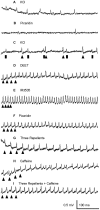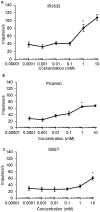Neurophysiological and behavioral responses of gypsy moth larvae to insect repellents: DEET, IR3535, and picaridin
- PMID: 24955823
- PMCID: PMC4067281
- DOI: 10.1371/journal.pone.0099924
Neurophysiological and behavioral responses of gypsy moth larvae to insect repellents: DEET, IR3535, and picaridin
Abstract
The interactions between insect repellents and the olfactory system have been widely studied, however relatively little is known about the effects of repellents on the gustatory system of insects. In this study, we show that the gustatory receptor neuron (GRN) located in the medial styloconic sensilla on the maxillary palps of gypsy moth larvae, and known to be sensitive to feeding deterrents, also responds to the insect repellents DEET, IR3535, and picaridin. These repellents did not elicit responses in the lateral styloconic sensilla. Moreover, behavioral studies demonstrated that each repellent deterred feeding. This is the first study to show perception of insect repellents by the gustatory system of a lepidopteran larva and suggests that detection of a range of bitter or aversive compounds may be a broadly conserved feature among insects.
Conflict of interest statement
Figures






Similar articles
-
Generic insect repellent detector from the fruit fly Drosophila melanogaster.PLoS One. 2011 Mar 16;6(3):e17705. doi: 10.1371/journal.pone.0017705. PLoS One. 2011. PMID: 21436880 Free PMC article.
-
Lethal and behavioural effects of three synthetic repellents (DEET, IR3535 and KBR 3023) on Aedes aegypti mosquitoes in laboratory assays.Med Vet Entomol. 2006 Sep;20(3):288-93. doi: 10.1111/j.1365-2915.2006.00630.x. Med Vet Entomol. 2006. PMID: 17044879
-
Commonly Used Insect Repellents Hide Human Odors from Anopheles Mosquitoes.Curr Biol. 2019 Nov 4;29(21):3669-3680.e5. doi: 10.1016/j.cub.2019.09.007. Epub 2019 Oct 17. Curr Biol. 2019. PMID: 31630950 Free PMC article.
-
Mosquito repellents for the traveller: does picaridin provide longer protection than DEET?J Travel Med. 2018 May 1;25(suppl_1):S10-S15. doi: 10.1093/jtm/tay005. J Travel Med. 2018. PMID: 29718433
-
Insect repellents.Med Lett Drugs Ther. 2021 Jul 12;63(1628):108-112. Med Lett Drugs Ther. 2021. PMID: 34543260 Review. No abstract available.
Cited by
-
The Repellent DEET Potentiates Carbamate Effects via Insect Muscarinic Receptor Interactions: An Alternative Strategy to Control Insect Vector-Borne Diseases.PLoS One. 2015 May 11;10(5):e0126406. doi: 10.1371/journal.pone.0126406. eCollection 2015. PLoS One. 2015. PMID: 25961834 Free PMC article.
-
In Search of Synergistic Insect Repellents: Modeling of Muscarinic GPCR Interactions with Classical and Bitopic Photoactive Ligands.Molecules. 2022 May 20;27(10):3280. doi: 10.3390/molecules27103280. Molecules. 2022. PMID: 35630759 Free PMC article.
-
Orthosteric muscarinic receptor activation by the insect repellent IR3535 opens new prospects in insecticide-based vector control.Sci Rep. 2020 Apr 22;10(1):6842. doi: 10.1038/s41598-020-63957-x. Sci Rep. 2020. PMID: 32321987 Free PMC article.
References
-
- Vosshall LB, Stocker RF (2007) Molecular architecture of smell and taste in Drosophila . Annu Rev Neurosci 30: 505–533. - PubMed
-
- Dickens JC, Bohbot JD (2013) Mini review: Mode of action of mosquito repellents. Pest Biochem Physiol 106: 149–155.
-
- Bohbot JD, Fu L, Le TC, Chauhan KR, Cantrell CL, et al. (2011) Multiple activities of insect repellents on odorant receptors in mosquitoes. Med Vet Entomol 25: 436–444. - PubMed
-
- Greico JP, Achee NL, Sardelis MR, Chauhan KR, Roberts DR (2005) A novel high-thoroughput screening system to evaluate the behavioral response of adult mosquitoes to chemicals. 21: 404–411. - PubMed
-
- Barnard DR, Xue R (2004) Laboratory evaluation of mosquito repellents against Aedes albopictus, Culex nigripalpus, and Ochlerotatus triseriatus (Diptera: Culicidae). Med Vet Entomol 41: 726–730. - PubMed
Publication types
MeSH terms
Substances
Grants and funding
LinkOut - more resources
Full Text Sources
Other Literature Sources
Miscellaneous

